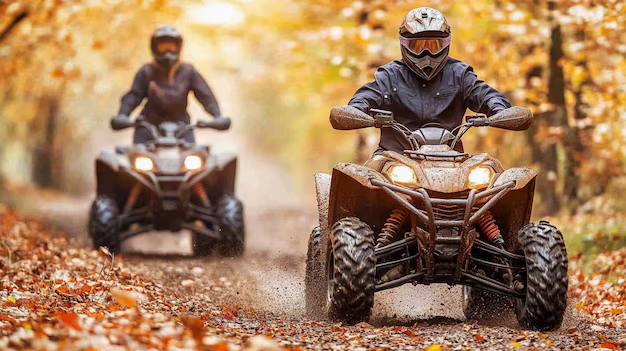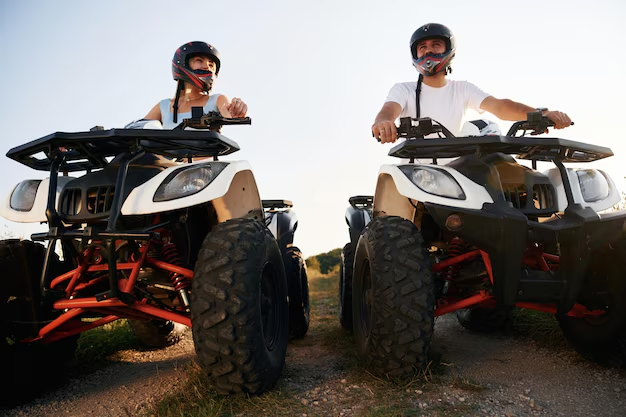UTV vs. ATV: Understanding the Safety Differences
When it comes to off-road adventures and utility work, two popular vehicle choices dominate the landscape: Utility Terrain Vehicles (UTVs) and All-Terrain Vehicles (ATVs). While both are designed to handle rough terrain, they differ significantly in design, functionality, and safety features. Understanding these differences is crucial for riders, especially those who are new to off-roading or using these vehicles for work-related tasks. Southbrook Safety & Consulting Ltd. emphasizes the importance of proper training and safety awareness to prevent accidents and ensure every ride is both enjoyable and secure.
This article will provide a comprehensive comparison of UTVs and ATVs, focusing on their safety aspects, common risks, and best practices for safe operation.
What is an ATV?
An All-Terrain Vehicle (ATV), often referred to as a quad or four-wheeler, is a small, straddle-seat vehicle designed for off-road use. ATVs are typically controlled using handlebars, much like a motorcycle, and are built for individual riders, though some models allow one passenger.
ATVs are ideal for trail riding, farming tasks, and navigating tight spaces thanks to their lightweight and agile design. However, this same agility also increases the potential for rollovers, particularly for inexperienced riders. ATVs often require riders to shift their body weight to maintain balance, which demands a certain level of skill and physical strength.
For those new to ATV operation, professional training is highly recommended. Southbrook Safety & Consulting Ltd. offers specialized ATV training programs to teach proper riding techniques, safety protocols, and hazard awareness.
What is a UTV?
A Utility Terrain Vehicle (UTV), sometimes called a side-by-side, is a larger, heavier off-road vehicle designed to carry two or more passengers. Unlike ATVs, UTVs feature a steering wheel, foot pedals, and side-by-side seating, making them more comfortable and stable for longer rides or utility tasks.
UTVs are popular for agriculture, landscaping, hunting, and recreational trail riding. Many models come with additional safety features, including roll cages, seat belts, and cargo space for tools or gear. These safety additions make UTVs a preferred choice for workplaces where off-road vehicles are part of daily operations.
If you’re considering learning more about UTVs, Southbrook Safety & Consulting Ltd. provides a UTV & ATV Safety Course in Alberta that covers both vehicle types.
Key Safety Differences Between UTVs and ATVs
While both ATVs and UTVs can be safe when operated correctly, their safety features and risks vary. Below is a detailed comparison:
| Feature | ATV (All-Terrain Vehicle) | UTV (Utility Terrain Vehicle) |
| Seating | Straddle seat for one rider (some for two) | Side-by-side seating for two or more |
| Steering | Handlebars | Steering wheel |
| Stability | Less stable, higher rollover risk | More stable due to wider base and roll cage |
| Safety Equipment | Helmet, goggles, gloves | Seat belts, helmets, roll bars |
| Passenger Capacity | One or two | Multiple (2-6) |
| Cargo Space | Minimal | Large cargo capacity |
| Training Needs | High, due to rider balance control | Moderate, driving skills similar to cars |
Stability and Rollover Risks
One of the primary safety concerns with both ATVs and UTVs is rollover risk. Due to their narrow wheelbase, ATVs are more prone to tipping over, especially on steep slopes or uneven terrain. Riders must use active body positioning—leaning forward or to the side—to maintain balance. Without proper training, this can be challenging for beginners.
UTVs, on the other hand, have a wider wheelbase and lower center of gravity, offering greater stability. However, their heavier weight means rollovers can be more dangerous if passengers are not wearing seat belts or secured by the roll cage. For both vehicles, helmets remain a crucial piece of safety gear, as head injuries are a leading cause of fatalities in off-road accidents.
To minimize rollover risks, consider enrolling in a UTV and ATV course where you can practice navigating challenging terrains under expert guidance.
Safety Gear Essentials for ATV and UTV Riders
Proper safety gear is critical regardless of which vehicle you operate. While UTVs may provide more built-in protection, riders should never compromise on wearing personal safety equipment. Essential gear includes:
- Helmet: Protects against head injuries, a must-have for all riders and passengers.
- Goggles: Shields eyes from dust, debris, and insects.
- Gloves: Provides grip and prevents hand injuries.
- Boots: Offers ankle support and protection against burns or impacts.
- Protective Clothing: Long sleeves and pants to guard against cuts and abrasions.
- Seat Belts (UTVs): Always wear seat belts in UTVs to prevent being thrown from the vehicle.
Southbrook Safety & Consulting Ltd. also emphasizes equipment maintenance, ensuring helmets and safety gear meet approved safety standards. For further assistance, you can contact their team for guidance on recommended gear.

Chainsaw Safety and Off-Road Vehicles
Interestingly, many ATV and UTV riders use these vehicles for outdoor work, such as forestry and farming, which often involves chainsaw use. Chainsaw safety is just as important as vehicle safety, as improper use can lead to severe injuries.
Before using a chainsaw, make sure you:
- Receive proper training and understand safety features.
- Wear chainsaw chaps, gloves, and helmets with face shields.
- Clear your workspace of debris to avoid tripping hazards.
- Use vehicles like ATVs or UTVs to transport equipment safely.
By integrating chainsaw safety practices with off-road vehicle use, you reduce risks on the job site. Learn more about chainsaw safety and training programs through Southbrook Safety & Consulting Ltd..
Training and Certification for Safe Operation
One of the most effective ways to stay safe is through formal training. Both ATVs and UTVs require skill to operate safely, and riders benefit from structured learning.
Southbrook Safety & Consulting Ltd. offers a comprehensive ATV training program designed to teach everything from vehicle controls to navigating difficult terrain. The UTV & ATV Safety Course focuses on understanding each vehicle’s mechanics, handling emergency situations, and practicing hazard recognition.
Investing time in training ensures riders:
- Gain confidence in controlling their vehicle.
- Understand terrain assessment and safe riding techniques.
- Learn proper loading and towing methods.
- Comprehend local laws and environmental guidelines.
Common Hazards Associated with UTVs and ATVs
Despite their versatility, both vehicles carry inherent risks, particularly for inexperienced riders. Common hazards include:
- Overturning or Rollovers: Caused by excessive speed or improper terrain handling.
- Collisions: Occur when visibility is poor or riders lack situational awareness.
- Equipment Failure: Due to lack of maintenance or pre-ride inspections.
- Passenger Risks: Carrying more passengers than recommended increases danger.
- Fatigue: Long rides without breaks can impair reaction time.
Through Southbrook Safety & Consulting Ltd., riders can learn how to mitigate these risks effectively. Visit their website for more information.
Tips for Safe Riding
Safe operation of ATVs and UTVs comes down to preparation, awareness, and responsible riding habits. Here are some tips to enhance your safety:
- Always complete a pre-ride inspection of your vehicle, including tire pressure, brakes, and fuel levels.
- Ride at a safe speed and adjust according to terrain.
- Never operate these vehicles under the influence of alcohol or drugs.
- Carry a first-aid kit and emergency communication device.
- Use vehicles for their intended purpose; ATVs are not meant for passengers beyond their capacity.
Conclusion
Understanding the safety differences between UTVs and ATVs is essential for making informed choices, whether you’re using these vehicles for recreation, work, or both. ATVs offer agility and maneuverability, while UTVs provide added stability and passenger safety features. Regardless of your choice, training, proper gear, and awareness are critical to preventing accidents.
Southbrook Safety & Consulting Ltd. remains committed to educating riders through their UTV and ATV safety courses, chainsaw safety programs, and hands-on workshops. By prioritizing safety, riders can enjoy the adventure and utility of these vehicles with confidence.
For more information on training or to schedule a session, contact Southbrook Safety & Consulting Ltd. today.
FAQ
1. Are ATVs more dangerous than UTVs?
ATVs are generally considered riskier due to their narrow base and balance requirements, making them prone to rollovers. UTVs are more stable but can also be dangerous if safety measures are ignored.
2. Do I need training to operate a UTV?
Yes, training is highly recommended to learn about proper controls, hazard recognition, and safe riding techniques. Explore the UTV & ATV Safety Course for detailed instruction.
3. What safety gear is essential for riding?
Helmets, gloves, boots, and goggles are essential for both ATVs and UTVs. For UTVs, seat belts and roll cages provide added protection.
4. How often should I inspect my vehicle?
Perform a pre-ride inspection before every ride, checking brakes, tires, and fuel levels. Regular maintenance reduces the risk of breakdowns.
5. Where can I learn more about chainsaw safety?
Visit Southbrook Safety & Consulting Ltd. for resources and training programs on chainsaw safety.

